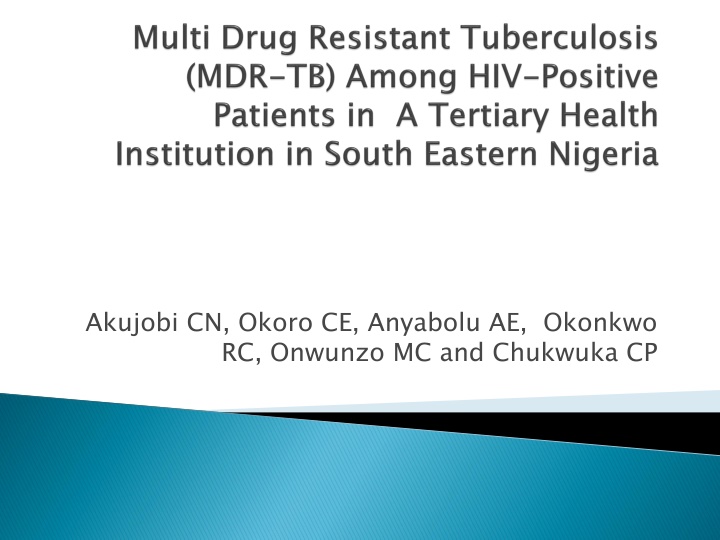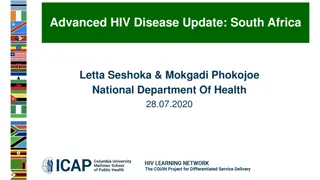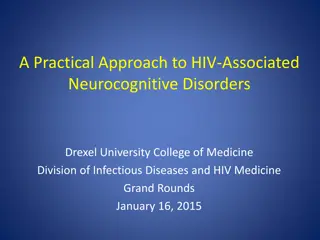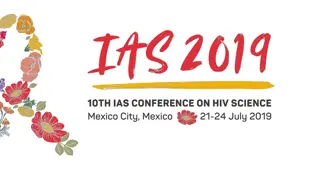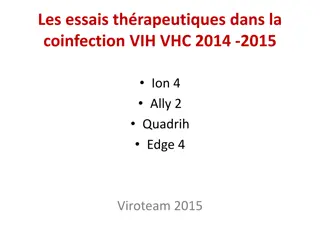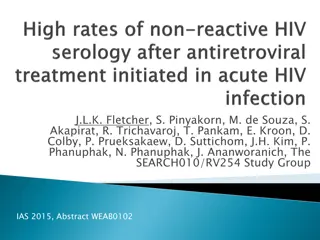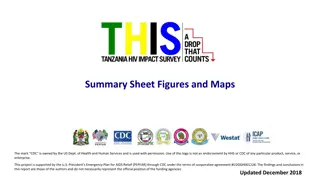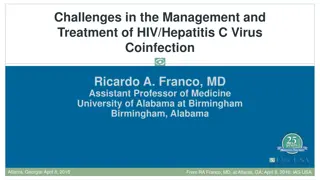Prevalence of MDR-TB Among HIV Patients in Nnewi, Nigeria
Tuberculosis (TB) is a significant issue among HIV-infected patients, particularly in Sub-Saharan Africa. This study focuses on determining the prevalence of Multi Drug Resistant Tuberculosis (MDR-TB) among HIV seropositive and seronegative patients receiving treatment in Nnamdi Azikiwe University Teaching Hospital, Nnewi, Anambra State. The study population includes patients receiving anti-Kochs therapy between January 2012 and June 2014. Sputum samples were collected and processed, aiming to shed light on the impact of MDR-TB in this region.
Download Presentation

Please find below an Image/Link to download the presentation.
The content on the website is provided AS IS for your information and personal use only. It may not be sold, licensed, or shared on other websites without obtaining consent from the author.If you encounter any issues during the download, it is possible that the publisher has removed the file from their server.
You are allowed to download the files provided on this website for personal or commercial use, subject to the condition that they are used lawfully. All files are the property of their respective owners.
The content on the website is provided AS IS for your information and personal use only. It may not be sold, licensed, or shared on other websites without obtaining consent from the author.
E N D
Presentation Transcript
Akujobi CN, Okoro CE, Anyabolu AE, Okonkwo RC, Onwunzo MC and Chukwuka CP
Tuberculosis (TB) is the most common opportunistic infection in Human Immunodeficiency Virus (HIV)-infected patients.1 HIV-infected patients are known to have 10% risk of reactivation of TB per year.2 They are more likely to die from TB than HIV negative patients.3
In Sub-Saharan Africa, 30% of HIV-infected patients who are diagnosed with TB die 12 months after the initiation of treatment.4,5 Nigeria has a HIV prevalence of 3.6% and has the world s third largest TB burden. It is also known that 26% of TB patients in Nigeria have HIV co-infection7.
Multi Drug resistant Tuberculosis (MDR-TB) is tuberculosis that is resistant to at least the first line anti-TB drugs, Rifampicin and Isoniazid.8 The emergence of Multi Drug Resistant tuberculosis (MDR-TB) is of concern to both patients and clinicians because of the attendant increased mortality and morbidity.
To determine the prevalence of MDR-TB among HIV seropositive and seronegative patients receiving treatment in Nnamdi Azikiwe University Teaching Hospital (NAUTH), Nnewi, Anambra State, South Eastern Nigeria.
The study population included:- HIV seropositive and HIV seronegative TB patients receiving anti- Kochs therapy from January 2012 to June 2014.
Sputum samples of TB patients were collected using the Directly Observed Treatment Short Course (DOTs) strategy specification. This involves collecting three (03) samples: (1) on the spot assessment of patients, (2) Another sample early morning next day (3) A third sample as the patient submits the second sample. Samples are labeled 1,2, and 3 with patient s identification parameters.
Specimens were processed using the Ziehl- Neelsen staining method, fluorescent staining technique and confirmed using the Gene Xpert by Cepheid, especially HIV positive cases with cough. The positive TB cases were referred to the DOTs clinic where they were commenced on anti-Kochs treatment with the Intensive phase using Rifampicin, Isoniazid, Pyrazinamide, and Ethambutol for two months
After the intensive phase of therapy, a repeat sputum microscopy was done to determine if the patient still had open TB, before continuation phase was started with Rifampicin and Isoniazid. In patients who still had open TB, resistance was suspected and their samples were sent for Gene Xpert confirmation. (Category 1 failure) (Gene Xpert confirms Tuberculosis infection but most importantly, it confirms resistance to Rifampicin).
At the completion of treatment i.e. after 6 months of anti-Kochs administration, the patients were rechecked to ascertain if they were cured. Any patient who still had a positive sputum sample was classified as Category 2 failure.
Out of 732 diagnosed TB patients seen between 2012 till date, only six (6) had MDR-TB (0.82%). Five (5) of the 6 were HIV-negative while only one (1) patient was HIV-positive. Of these 6 MDR-TB patients, two (2) have been completely treated, two (2) have died, one (1) patient is still receiving treatment while the other person is not on treatment because of the cost.
In Hospital, the anti-Kochs regimen used is 2 months Rifampicin, Ethambutol, continuation Isoniazid. Nnamdi Azikiwe University Teaching intensive Isoniazid, followed phase treatment phase with and Pyrazinamide by using 4 months Rifampicin and It is expected that by the end of the two months intensive phase of treatment, patients with treatment should no longer have open TB. open TB who adhered strictly to
The conventional methods of detecting resistance involves growth/culture of Mycobacterium tuberculosis on liquid or solid culture medium and drug susceptibility testing.10
They should no longer have the bacilli in their sputum. A re-check of the sputum is done at this stage to know those who have responded well to treatment. Patients who still have open TB are classified as treatment Category 1 failure. Their sputum samples are further subjected to resistance testing using Gene Xpert which detects rifampicin resistance and may not detect isoniazid mono resistance.
The prevalence of MDR-TB in the study was 0.82%. This is much less than what other researchers found. Dinic et al had 5.5%11in treatment na ve patients while Uzoewulu et al had 8%.12 This could be due to the fact that Nnewi is an urban city and the teaching hospital is situated there so there is better access to medical care . It is also pertinent to mention here that patients were closely observed/monitored during treatment .
The result shows that most of the patients were Category 2 failure, and there was poor compliance to treatment irrespective of their HIV status. It is important to note that although TB is a common opportunistic infection in HIV patients, HIV itself does not predispose to MDR-TB so long as the patient complies with anti-Kochs regimen13-16.
MDR-TB poses a challenge in the management of HIV/TB co-infection because of poor treatment outcomes, higher treatment costs, lack of adequate treatment centers. Prevention still remains the better option. All hands must be on deck to prevent or reduce MDR-TB by monitoring TB patients on treatment. As is usually said DOT the I s and Cross the T s to prevent resistance.
Only smear AFB and Gene Xpert testing were employed in the study. DST was not done due to unavailability of culture centres, but the future work would incorporate that and others. The study did not separate patients into those already on treatment and treatment na ve.
1. Schmaltz CA, Morgado MG, Louren o MC, Grinsztejn B, Rolla VC. Effectiveness of highly active antiretroviral therapy (HAART) used concomitantly with rifampicin in patients with tuberculosis and AIDS. Brazilian Journal Of Infectious Diseases; 13:26-34. Sant Anna FM, Velasque L, Costa MJ,
2. microbiology made ridiculously simple. Edition 3. 2006. Page 134. Mark Gladwin, Bill Trattler. Clinical 3. GH, Klein RS, Schoenbaum EE. High risk of active tuberculosis in HIV-infected drug users with cutaneous anergy. JAMA. 1992 Jul 22- 29;268(4):504-9. Selwyn PA, Sckell BM, Alcabes P, Friedland
4. Harries AD et al. Deaths from tuberculosis in sub-Saharan African countries with a high prevalence of HIV-1. Lancet. 2001 May 12;357(9267):1519-23. 5 tuberculosis on survival of HIV-infected adults: a prospective epidemiologic study in Uganda. AIDS. 2000 Jun 16;14(9):1219-28. Whalen CC et al. Impact of pulmonary
6. Technical report: National HIV Seroprevalence Sentinel Survey, 2010. p1-110. Federal Ministry of Health, Nigeria. 7. tuberculosis control: WHO report,2010. World Health Organization. Global
8. Mekonen A, Suarez P and Ameni G .2013. Determinants of Multidrug resistant tuberculosis in Patients who underwent first- line treatment in Addis Ababa: a case control study. BioMed Central Public Health. 13:782 Hirpa S, Medhin G, Girma B, Melese M,
9. resistant tuberculosis now at record levels. http://www.who- int/mediacentre/news/releases/2010/drug_resi stant_tb_20100318/en/ World Health Organization (WHO): Drug- 10. MDR-TB and XDR-TB response plan. 2007. World Health Organization. The global
11. drug- resistant tuberculosis among HIV- infected patients in Nigeria. J Clin Microbiol. 2012 Sep;50(9):2905-9. doi: 10.1128/JCM.00982-12 Dinic L et al. Genetic determinants of 12. Umenyonu N, et al. (2014) Drug Resistant Mycobacterium tuberculosis in Tertiary Hospital South East, Nigeria. J Med Microb Diagnosis; 3:141. doi: 10.4172/2161-0703.1000141 Uzoewulu NG, Ibeh IN, Lawson L,
13. Kledjo B, Gninafon M, Anagonou SY, Portaels F. Antituberculosis drug resistance among new and previously treated pulmonary tuberculosis patients in Cotonou, Benin. Int J Tuberc Lung Dis. 2007;11(11):1221-1224. Affolabi D, Adjagba OABG, Tanimomo-
14. Diand S, Sangar L, Kouanda S, Dingtoumda BI, Traor AS. Drug Resistance of Mycobacterium tuberculosis Complex among Newly Diagnosed Tuberculosis Cases in Burkina Faso. WAJM. 2009;28(6):353-357. 15. . Sangar L, Diand S, Badoum G, Dingtoumda B, Traor AS. Anti-tuberculosis drug resistance in new and previously treared pulmonary tuberculosis cases in Burkina Faso. Int J Tuberc Lung Dis. 2010;14(11):1424-1429. (Study 1)
16. alysis of drug resistant tuberculosis in Sub- Saharan Africa: how strongly associated with previous treatment and HIV co-infection? Ethiop J Health Sci. 2013 Nov;23(3):271-82. Berhan A, Berhan Y, Yizengaw D. A meta-
Thank you. Thank you.
